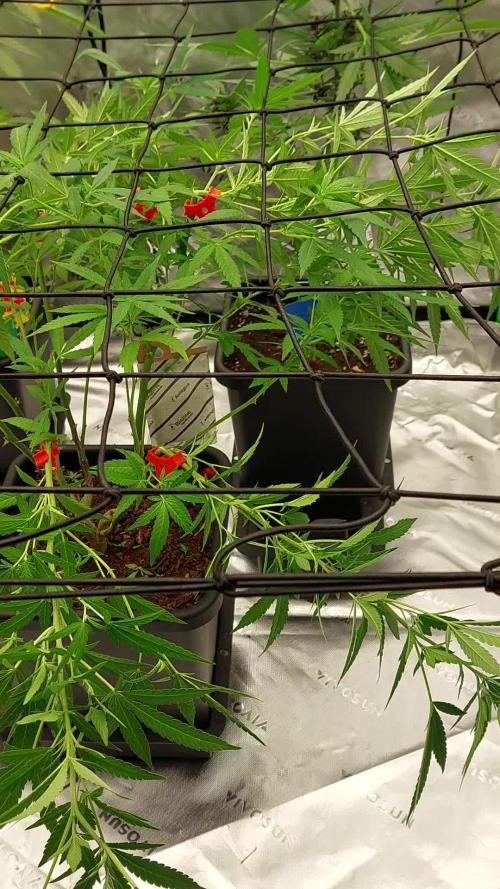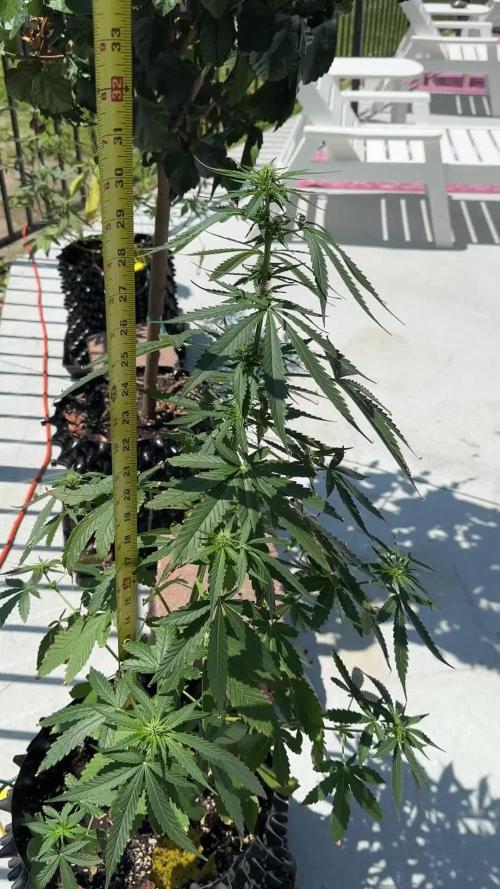The Grow Awards 2026 🏆 





































Likes
Comments
Share


@Mr_und_Ms_Lue_Roots
Follow
Hallo liebe Gartenfreunde,
Es gab Bei uns Standort Veränderungen. Der gesamte Damen Balkon ist heute Morgen in den Indoor Bereich gezogen. Die Umwelteinflüsse waren kaum noch auszuhalten. Alle samt haben vorher SF- Nematoden inkl. Raubmilben- Beutel verabreicht bekommen. Zusätzlich konnten wir auch die lästigen Ameisen bekämpfen bis stanDie re veg P.C.K. ist in das 60er Zelt und verbringt ihre Freizeit dort allein. Warum,? Sie befindet sich noch nicht wieder in der Wachstumsphase und kann natürlich immer noch im HEMA Bereich anfangen zu zicken. Bisher nach Kontrolle bei heutigem Entlauben, keine Anzeichen gefunden.
Ja die P.C.K Dame die sich gut im und hier noch gut erholt hat, steht wieder sehr nett da 🤩
Nach dem Umzug heute wird jetzt bis Samstag immer eine Stunde weniger Licht auf dem Programm stehen, so das sie am Samstag dann Blütetag 1 erreichen. Ja ansonsten freuen wir uns auf die kommende Woche und wünschen allen somit auch eine angenehme und erfolgreiche Woche!
Vielen herzlichen Dank auch im Voraus für das reinschauen, ggf. Liken und oder kommentar!
VG ✌️
Likes
23
Share


@Susquihanna
Follow
OMG! Miss Gorilla was showing her strength this week and grew a whopping 9 inches this week. The sun is shining and she is drinking 1 gallon of nutrients a day.
@Fastbuds website says, "Plant Appearance This lady likes to stay low and will usually grow to a height of 60-130cm. Her growth structure is short and bushy, thanks to her sativa dominance, and will grow one main central cola, with fat side branches all around. Once flowering starts, expect Gorilla Auto to fill out thick and fast, as she begins to pack on size, weight and go crazy with the trichome output. From seed to harvest she is ready in 9-10 weeks, where she will finish with a short and fat appearance."
So far, Miss Gorilla is keeping up to her description.
I took a magnified picture and it shows me that Miss Gorilla will probably be in flower next week. It looks like she is in the beginning stages of flower.
@Fastbuds website said to, "add support around this strain, to help the side branches during the flowering stage" which I have done by LST with her side branchs. I have tied them down to allow light in and support growth.
I am feeding her 1 gallon on nutrients a day right now and @Fastbuds website said, She can take a big feed especially during week 3 and onwards." So, I am on target with that information.
I also have a pool umbrella protecting all of my plants from the direct sun.
As always, please comment and let me know what you think of Miss Gorilla.
Likes
15
Share


@JeyGanesha
Follow
Iniziò seconda settimana ,sé tutto procede più che bene...da questa settimana inizierò a darGli anche un pochino di Ph perfecto 😉💪👍..........
Oggi all'11 °giorno ho tagliato via 2 foglie perché ho trovato delle macchie di ruggine su 2 foglie......
Likes
25
Share


@JeyGanesha
Follow
Queste korngarden seeds mi stanno stupendo di giorno in giorno.complimenti..
Cresce a vista d'occhio.ho dovuto pure piegarla in testa sennò troppo alta veniva
Likes
37
Share


@XII_XII_MrGreen
Follow
Things are moving along she stopped stretching, and they are all about the same height now in the tent 😁..
I've changed the feeding schedule and for now it's straight forward to some nice buds hopefully 😊
Have a great week everyone and till the next 🤙🏻
Processing
Likes
Comments
Share


@MG2009
Follow
06/01/2020
Time to make the seeds!
First my Cookie Cake F1 plant is a 7 star cookies male
(Top dawg seeds) X a female Captains cake clone
(Captains connection) and will be growing TLO Style.
7 Stars Cookies Strain | Marijuana Strain Reviews
50% Sativa /50% Indica
THC: 22% - 27%
7 Stars Cookies is an evenly balanced hybrid strain (50% indica/50% sativa) created through a potent cross of the classic F1 Durban X Girl Scout Cookies strains. This potent bud is infamous among cannabis users for its super high potency and long lasting effects that are perfect for any hybrid lover. The 7 Stars Cookies high starts with a rush of cerebral effects that rush though your mind, lifting your spirits and leaving you blissfully happy and unfocused. As your mind flies higher and higher, your body will begin to slip away into a state of deep relaxation that leaves you totally stoned and out of it. A sharp pang of hunger comes next, leaving you with a ravenous case of the munchies as your mind slips in and out of calming sedation. Thanks to these effects and its super high 22-28% THC level, 7 Star Cookies is often chosen to treat those suffering from conditions such as chronic pain, insomnia, stress, depression, and migraines or headaches. This bud has a sweet citrusy flavor with hints of spicy earthy grape upon exhale. The aroma follows the same profile although with a light pungency to it. 7 Star Cookies buds have fluffy dense popcorn-shaped olive green nugs with bright orange hairs and golden crystal trichomes.
Captain's Cake Marijuana Strain Information
About Captain's Cake
Hailing from the beautiful land of Maine, Captain’s Cake is brought to us by The Captain’s Connection. This indica-dominant strain boasts two pretty incredible parents, Girl Scout Cookies and White Fire Alien OG, making her a bud that offers great effects for both recreational and medical patients. While Captain’s Cake typically acts as a true hybrid, user sensitivity may dictate that your experience comes with the roll of the dice.
A fairly potent strain in her own right, Captain’s Cake averages around 21% THC. Rumor has it that CBD levels can vary dramatically, with some reports showing a range between 1% and 15%. While that data remains to be confirmed, you can instead relish in beautiful buds that are bright green, featuring orange pistils and lovely amber trichomes. Oddly enough, flavors and scents do vary a bit with this strain, and you’ll notice it smells much worse than it tastes. A sour and earthy fragrance that includes lemon, nuts, and berries will hit you right away while your mouth enjoys a nutty vanilla cookie experience that’s slightly citrus-like.
Captain’s Cake is awesome for those times when you need a boost of energy to get through a particularly trying task. Whether you’re experiencing the three o’clock workday slump or you simply have to clean the house before it gets any worse, this strain is here to help. Users note a euphoric boost that helps you to focus on your tasks while having a huge smile on your face, but keep in mind that this joyful experience can only last so long. Soon the munchies will hit, and after you’ve had your fill of snacks, you’ll be ready to settle in during a sedating comedown.
Even if Captain’s Cake doesn’t have an astounding amount of CBD, medical patients still note that she’s a strain that is practically magical. Users find that mental woes are easily dissolved after taking a few hits, making stress and depression a thing of the past. Bodily aches and pains are also treated with a slight feeling of physical sedation, and those who struggle with their appetite will likely turn to this bud time and time again.
This plant is an ideal choice for new and experienced growers, and the ability to cultivate inside or out makes her pretty versatile. Said to be a quick flowering strain, you’ll be gifted with a nicely sized yield after 8 to 9 weeks. Plants tend to grow fairly large, so make sure you have enough space dedicated to your crop before you begin.
Depending on how you handle marijuana, Captain’s Cake may knock you out for an amazing nap or in some cases may fire you up with tons of energy. Others will experience a nice set of hybrid effects, so it’s best to know yourself before lighting this one up.
Red Sky is
Description
The (paternal P1) father is the legendary Cherry Hemmingway male. A hybrid of a landrace Bhutan, and Rez Dog’s Firecracker (Williams Wonder x NYC Diesel).
The female KOS’s own Skyanchor (Bogglegum x PSI) a cross using a prime selected male of BOG’s Bogglegum. A bad ass old-school hybrid made using a Northern Lights #5 (real deal) crossed to a Bubblegum (real deal). The female used to make the Skyanchor was my clone only PSI (Purple Salem Indica) that I was given by my good friend Keith, in Salem, OR, USA. Some kind of crazy old Purple Kush variant; potency is not only severe with this baby, but supernaturally intense.
The Cherry Hemmy is well known by me to relate large yields and incredible vigor along with increased resin production, and also usually relates cream soda, vanilla, or cherry-ish terpenes, making exotic and addictive combinations when used as part of any hybrid. So, the Red Sky yields well—very well.
Some truly legendary strains involved in this Small Batch Seed run.
Great genetics equals great end results.
I put video of Red Sky #3's brothers #2, and #4.
Likes
25
Share


@Susquihanna
Follow
Whew, I am a few days late in posting but I have been MIA. Glad to be back to my plants and gardening. My faithful follower @hindugod even reached out to me to see why I was late in posting my pictures.
A Disney Vacation was good for me but not so much for my plants. I also left my husband and two livestock in charge of feeding and protecting my plants from the elements of nature. Miss Mango Kush continues to grow tall. According to Zamnesia Seeds, she could reach a height of 38 inches outdoor. Our weather has been kinda crazy and hellish- as in HOT- and her leaves are getting burned on the edges even though I have a pool umbrella protecting her from the direct sun.
Miss Mango Kush is NOT a bushy plant but rather a tall, lean plant. If you look at her pictures, you can see a lot of buds forming.
It has been quite hot this past week, but hopefully we will get a break in the weather. Please continue to enjoy my diary and let's chat it up friends.
Likes
195
Share


@StarLorr
Follow
Hello 👋🏼 Readers,
I didn't do much this week besides feeding the Triplets and giving them love
I introduced them to Monster Blaster this week and seems to like it😀
I haven't potted the clones yet😅
But sooner the better as one start having tiny pistils on top, might have to get them out for longer daylight and need to get perlite as i have a bag of Coir but no perlite to mix it with🤦♂️🏻
That's all for this week,
Thanks for stopping by and liking or commenting it's always greatly appreciated😃
Wish you all a great week.
👊🏻😎
Likes
9
Share


@MacBrGrow
Follow
I was a little away because of work and travel, but I'll show you from now on until the harvest, let's do it
Likes
13
Share


@gr3g4l
Follow
15 dias a 12/12h. Iniciamos la semana mostrando claros simptomas de floración.
Por lo que hace a la araña roja comentar que no ví ni una en un par de foliolos o hojas que estube mirando pero si ví que habian quedado huevos o larbas pegadas en los nervios del foliolo. Esta semana nueva fumigada y esta vez cambiando de producto. Son ya varios cultivos utilizando lo mismo y es muy posible que a las arañas no les haga ni cosquillas, por lo de la inmunidad.
Una pequeña poda de los segundos nudos y para más adelante una última de bajos y chupópteros y así dejarlas ya tranquilas el resto del cultivo.
Como puede observarse esta semana han vuelto hacer una buena estirada, entiendo que al ser 9 en tan poco espacio todas miran de competir por cual recibe más luz creciendo como locas. De esta solo puedo esperar que salgan unos bonitos cohetes. A final de semana estarian en 80 ctms las más altas y 65 ctms las más peques.
Likes
361
Share


@Ju_Bps
Follow
Hello my friendly growmies 👩🌾👨🌾🌲🌲,
We start to be really close to the harvest 🌲✂️, trichromes not yet ready but soon, I like a few percentage of amber, they are almost totally milky, so probably ready in end next week 🙂🙂
Smeel fruity/diesel
💦 1 watering this week 2.75l/plant
Water + flash clean
Lamp @100% and start to be really close to the plant, but not burning sign for the moment.
Thanks community for follow, likes, comments, always a pleasure 👩🌾👨🌾❤️🌲
Have a nice end years 2022 💜👨🌾👩🌾🎅
See you new year 🍻🥂🥃🥃💨💨
Mars Hydro - TS1000 💡💡
https://www.mars-hydro.com/ts-1000-led-grow-light
Mars Hydro - FC3000 💡💡
https://www.mars-hydro.com/fc-3000-samsung-lm301b-led-grow-light
RQS - Fat Banana Auto 🍌🍌🌲🌲
https://www.royalqueenseeds.com/autoflowering-cannabis-seeds/487-fat-banana-automatic.html
Likes
7
Share


@Cogollo_eu
Follow
From/Desde: 30/06/18 || To/Hasta: 06/07/18
Think Big A: From day/Desde día: 29 || To day/Hasta día: 35
Think Big B: From day/Desde día: 19 || To day/Hasta día: 25
-----WEEK SUMMARY-----
30/06/18: Video 1 & Photos 2 to 4
01/07/18: Photos 5 to 8
02/07/18: Photos 9 to 13
04/07/18: Photos 14 to 16
The video shows one morning i went to my friend house, just to record at what time the plants get the firsts rays of light. As i told in the first week, this summer i didn't growed at my home, so this is the only morning i came to check the sun raise.
Finally the second Think Big became a Bermudas Triangle, she's growing mostly horizontal as you can see, meanwhile, the first Think Big entered into flora stage, she's going to create a small "cola" and very very soft, i'm never going to harvest this plant.
*****ESPAÑOL*****
-----SUMARIO SEMANAL-----
30/06/18: Vídeo 1 y Fotos 2 a 4
01/07/18: Fotos 5 a 8
02/07/18: Fotos 9 a 13
04/07/18: Fotos 14 a 16
El vídeo muestra un timelapse de una mañana que fui a casa de mi amigo a comprobar a que hora empezaban a recibir luz las plantas. Como comento en la primera semana de este diario, este verano no he cultivado en mi casa, y esta es la única mañana que iré a comprobar el amanecer.
Finalmente la segunda Think Big se ha convertido en el triángulo de las Bermudas, esta creciendo muy horizontalmente, mientras tanto, la primera think big ya ha entrado en flora, va a crear una pequeña cola muy muy blanda, nunca recolectaré esta planta.
Likes
31
Share


@Targona
Follow
17/10/2022 - 71 days since my little girl sprouted from seeds🌱
The sixth week of flowering of my BCN Power Plant 🌴🌴🌻
Nutrients:
Jungle Indabox - I will still be serving this week and I am adding Jungle Indabox Environ X - bud stimulator 🌼🌸🌼
Advanced Nutrients - Big Bud - I canceled the bud stimulator mix and stayed with Jungle Indabox because the other girls got a little burnt, the classic brown color appeared on the tips of the leaves 🍃🍂
I stuck with Bud Candy, all my girls need lots of carbs 🍭🍭
Atami - ATA Calmag - when growing under LED lights it is recommended to use Calmag and Atami is an excellent brand
Training:
I only defoliated again, not as much as last week, but I still see too many leaves in the buds 😩 🍃🍃
Light: Believe - the best light of sponsor Mars Hydro TS 1000 💡💡
In general:
The plant is strong, manages nutrients well, absorbs as needed. The leaves are still deep green, you can see that it is a sativa. So far, there is no indication that it is nearing its end.
As far as flowering is concerned, it is the slowest so far - compared to the other ladies in the box. It still only has white pistils, only occasionally some brown, and the flowers are not yet fully formed 🏵️💮 I think at least within a week.
It smells really beautiful, it revealed its spicy scent 🌶️🌍
Thanks for the likes and you can follow me on Twitter 🐦: @ Targona666
See you soon 😍
Likes
2
Share


@GroloCup
Follow
Flower season is upon us... The LST has continued and she's bouncing back with every bend and twist. Very promising look to the plants growth. She seems happy with the amended soil and the addition of CalMag+, so we seem to be good to go on this one.
Likes
24
Share


@SmallBatchNugz
Follow
The ladies are thriving, flipped to 12/12 today, put in week 1 of flower nuts and after 1 week of that.. I will put in my flower spectrum light for maximum results.
Likes
6
Share


@thisisgroot
Follow
Week 4 started.
Defoliated on day 21. Looks like they're fine with it 😉
The smell is ridiculous. I cannot touch them without them stinking like crazy (and me with them).
Got that frost going on, hope they'll keep it coming!
Likes
2
Share


@Valley
Follow
Buds werden immer dicker, Klebriger und süßer im Geruch
Cold Flush wird anfang nächster Woche einmal durchgeführt
Likes
86
Share


@Ageddd
Follow
The flowers are getting heavier and developing more resin, this week im using Top Bud (Final touch bud fattener) with the rest of nutrients...
Feeding Schedule
WATER / TOP BLOOM + TOP BUD + TOP CANDY / WATER / TOP BLOOM + TOP CANDY / WATER
Likes
5
Share


@Ninjabuds
Follow
Buds and leaves are starting to have a black hue to them the plant is starting to fourm decent buds they have a lot of resemblance to the gas cream Runtz and some of the bubble og phenos





















